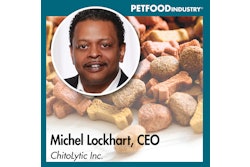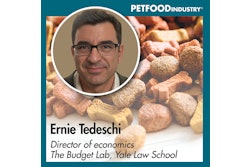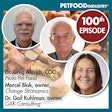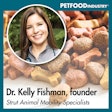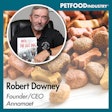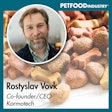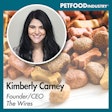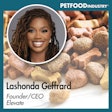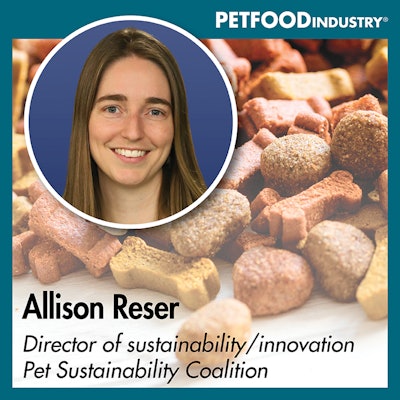
In this episode of Trending: Pet Food, the discussion centers on the evolving role of sustainability in the pet industry. Together, host Linday Beaton and Allison Reser, director of Sustainability and Innovation at the Pet Sustainability Coalition, break down how sustainability applies to everything from employee welfare and community outreach to environmental impact and animal welfare. The conversation also explores why sustainability remains a complex issue in pet food, from navigating regulatory drivers to balancing cost, ROI, and effective consumer communication without falling into greenwashing.
Transcript
The transcript below is from Episode 84 of the Trending: Pet Food podcast, where host Lindsay Beaton and Allison Reser, director of Sustainability and Innovation at the Pet Sustainability Coalition (PSC) explore how the pet industry is navigating the growing demand for sustainability, from environmental impact to ethical sourcing and consumer expectations. You can find the episode at Trending: Pet Food Podcast, on SoundCloud or on your favorite podcast platform. This episode originally aired on April 9, 2025.
We want to thank Coperion for sponsoring this podcast. Coperion brings together some of the world's most trusted technology brands to offer innovative system and ingredient automation solutions to pet food producers worldwide.
Lindsay Beaton, editor, Petfood Industry magazine and host, Trending: Pet Food podcast: Hello, and welcome to Trending: Pet Food, the industry podcast where we cover all the latest hot topics and trends in pet food. I’m your host and editor of Petfood Industry magazine Lindsay Beaton, and I’m here today with Allison Reser, the director of sustainability and innovation at the Pet Sustainability Coalition. Hi Allison, and welcome!
Allison Reser, director of Sustainability and Innovation at the Pet Sustainability Coalition (PSC): Hey, Lindsay. Nice to be here.
Beaton: In case you’re unfamiliar with Allison or PSC, here’s what you need to know.
Allison is a sustainability leader driving change in the pet industry. At PSC she leads initiatives on climate action, packaging, and responsible sourcing. With a master’s in Sustainability Management from Columbia, she brings experience in environmental education and the circular economy. Allison is based in Boulder, Colorado, where enjoys riding her relatively new gravel bike and spending time with her cat, Nova.
The Pet Sustainability Coalition is a nonprofit that advances business through profitable environmental and social business practices. Founded in 2013 by eight companies, PSC now serves about 200 member companies across the pet industry and around the world. PSC helps companies make progress on their sustainability practices, set and strive for ambitious goals, and report on their achievements. Additionally, PSC leads retailers, distributors, manufacturers, brands, and suppliers in pursuing collaborative solutions to some of the largest industry-wide issues, such as sustainable packaging and protein sourcing.
Allison Reser is the speaker for the opening session of Petfood Essentials, our precursor to Petfood Forum 2025, being held at the end of this month. She’ll be presenting “How to start your sustainability journey” as the start of our day of sustainability education at Essentials. This, along with Allison’s commitment to sustainability and her experience in helping businesses work towards their sustainability goals, is why I’ve brought her on today to answer this question: Where are we at with sustainability in the pet space?
So Allison, we're going to talk a lot today about how the idea of sustainability has evolved in the broader minds of humanity, as well as in a business sense. But I want to start out by asking you how you think sustainability became such an important conversation in the pet space?
Reser: I love that this is where you're starting the conversation, because I think so many times we jump right in to, “Okay, what do I do? What are the actions I can take?” But it's super important to remember why we are doing this and what we are talking about.
I wanted to quickly say that when we say the word “sustainability,” we're talking about it broadly. I think in the pet space, we see a lot of these three pillars: people, planet and pets.
Of course, the people side of sustainability, we're talking about employees and workers in the supply chain, community outreach. That community outreach piece is something the pet industry is stellar at -- giving back and volunteering.
The planet side of sustainability is a lot of stuff about your nature footprint, so a business's impact on air, on the water, on the land.
Then, of course, the pet side of sustainability is a fun one that we have uniquely in the pet industry. We're talking about the animal welfare of our pets, but also the animals that are used as ingredients. That’s the level setting. “Sustainability” is very broad. There's a lot of different ways companies can think about it.
How did it become such an important conversation? It really became an important conversation a long time ago. In the 70s and 80s, that's when people started to realize, “Oh, maybe companies should actually do the right thing, do good for the world,” rather than just supply us with something that we need.
That was spurred on by public outcry from the Exxon Valdez oil spill of 1989. After that, people started to think, “Yeah, business should do the right thing.” It shouldn't come at the cost of our environment or of people's welfare.
There’s a lot that went into the evolution of corporate sustainability, but one of the notable things was the launch of GRI, the Global Reporting Initiative, that happened in 2000. There were 31 companies that piloted it. I looked at those 31 companies, and there's some representation in pet. I wanted to say that the pet industry has been there from the very beginning of corporate sustainability.
At this point, there's a lot of data that just shows us that people want it. Every year we see new data. Recently, I've seen some stuff about how 50% of pet owners are willing to act on sustainability; 57% are likely to buy from a brand that is committed to reducing environmental impacts. We could talk a lot about the data, but people want sustainability in their pet products, and they seem to really care about it.
Beaton: We are having this conversation coming off Global Pet Expo and the Pet Summit, which I attended. I attended the sustainability track where there was a lot of discussion about the complexities of sustainable practices in pet -- what various aspects the industry need to focus on, what sustainability means to all these different parts of the pet space. What do you think are the current top complexities that are gripping the pet space when it comes to trying to get a handle on sustainability and what it means for the different parts of the supply chain and creating pet food?
Reser: It is complex. As much as I want it to be very simple, that sustainability is just something everybody should do, that's not the reality.
I think a couple of things make it complex. First, there's different reasons to even do it. There are voluntary reasons to do it, like it's baked into your brand ethos. For some, there are certain compliance reasons to do it, like you must measure your greenhouse gases if you live in certain states or countries and you're of a certain size, or you must start paying for packaging through the EPR laws -- voluntary compliance. There is also a middle ground where there's a semi-voluntary space, where if you want to appeal to more investors or vendors or customers, you need to start reporting on your sustainability progress. So, even the reasons to engage can be complex.
From there, of course, cost is a big complexity. We love to make the business case. There are some projects that have a very clear ROI. For example, if a company is considering renewable energy, there's usually a calculation – yes, the cost of installing a solar panel eventually will pay for itself because you're not paying for electricity. Those kinds of projects are awesome to work with, because it's a win, win, win.
Other times, ROI is a lot squishier, because we like to make the case that, yeah, consumers want sustainable products, so investing in this, telling the story, educating your customers, will lead to increased sales. But there are a lot of unknowns in that equation into the future. Markets are complicated.
The other big complexity is consumer storytelling. We live in a space, in the pet industry, and in a lot of industries, where there are some very legitimate third-party certifications and on-pack label that clearly communicate to the customer that this product has achieved some sort of sustainability.
There are also the “field of green claims,” where companies are welcome to tell their sustainability story beyond just those third-party certifications. But of course, then we get into greenwashing -- misleading claims or overstating how sustainable a product is -- which leads to a lot of confusion for customers.
Beaton: Let's talk about greenwashing a little bit more, because one of the conversations I've heard about greenwashing lately is that it'll be a self-correcting mechanism. Consumers have so much access to information -- everything is just a Google search away -- that they will find out quickly if you're BSing them.
Do you think that it's more complex than that? Is greenwashing becoming a bigger issue? Is it a smaller issue? Do you think companies are doing it on purpose, or is it just kind of a natural result of them trying to be more sustainable? Where do you think greenwashing is sitting, on the industry side and then on the consumer side?
Reser: It's probably getting more and more complex as we go along. Greenwashing started just when very smart marketers were like, “Oh, people seem to like to buy things that use the word ‘ecofriendly’ or has a little picture of a leaf next to it. Let's just put that on our product, brand ourselves as ecofriendly and see if that works.”
Of course, that's problematic, because you must be doing the work behind the scenes to reduce your impact in some way or improve it. What makes it more complex now is, like you said, there are very smart consumers that caught on to this, and they're saying, “You’re lying to our face. Please stop.”
Now we're in a space where greenwashing is illegal in many places, and so it's regulated. We see some companies just going in the other way, which is what we call “greenhushing,” where a company might have the most robust sustainability strategy. They are making progress towards good targets in their environmental impact, but they just don't tell that story because they’re like, “We don't want to deal with greenwashing laws. We're doing this because we know it's the right thing to do but we’re not telling that story.”
That's, of course, problematic, because it's even more confusing for the consumer. I don't really know what to do about that. I think there's a lot of different methods, because not everybody is going to do that research.
What I learned is there are different levels of consumers that a great green claim should appeal to. There is one level of consumer that wants a quick 30-second check, so a claim on-pack or something obvious to say, “This product is doing good.” Then the next level of consumer would like a QR code or a website where they can research that immediate claim to see if it's legit.
Then there is a third level of consumer, which is probably where I sit when I shop, because I'm a nerd about this stuff. Not only will I go to the website, but I'm going to look for their impact report, or the stuff that's not even graphic-designed because it's so technical. I want to follow -- did they do that life cycle assessment that they said that they did?
Most people are at that level where they want to take 30 seconds to explore, is this product good or bad? There’s a lot of thought that needs to go into that language to be very specific and clear beyond just saying “we're ecofriendly and here's a leaf” with all those complexities.
Beaton: How open have you found the pet industry to be in terms of implementing sustainable practices? Are there segments of the industry that are finding it easier to implement than others? For example, end consumer brands can have a very visual sustainability impact, but if you are an ingredient supplier, your sustainability initiatives might look very different and are for a very different audience. How has all of that been playing out in the pet industry?
Reser: I have a bit of personal experience that makes me very excited to work in the pet industry because it is rather innovative and open to change. For a while, I worked in the movie and TV industry trying to implement sustainability. It is so regimented on set for some productions that even if you just want to add a little compost bin, it is like pulling teeth.
Compared to that experience, I just know that there are other industries where any change is super hard. The pet industry is in a good spot, because the companies that we're working with seem adaptable and open to change and open to collaborating along the supply chain, and quite innovative.
Coming back to your question, I'm in a fortunate position because I'm working with a segment of the pet industry that has joined PSC as a member. What we're trying to do is create that space for pre-competitive collaboration and information sharing.
Of course, we see this happening outside of our coalition. I think one of my favorite examples was a panel where a bunch of smaller brands using innovative ingredients were talking about, how did they find this ingredient? Why are they using it? One of the points they made was they want other companies to use this same ingredient, because scaling that supply chain and making it more accessible, builds their resilience. It's more about that, rather than a competitive advantage. That’s been exciting to see as companies are willing to band together to create that supply chain resilience.
Our suppliers seem down to work with each other, too. In a lot of situations, I've seen packaging suppliers on stage with each other for the same panel, having a discussion. Again, we in the pet industry can work in that pre-competitive mindset.
Beaton: When companies are coming to you asking questions about sustainability, whether they want to refine their current plan, whether they don't even know how to define sustainability with their own business? What are the top questions you get asked when people first come to you guys?
Reser One of the most common reasons people come to PSC is, “Oh my gosh, a vendor or a potential customer of mine is asking for my greenhouse gas inventory. I don't know what that means. Please help.” We're like, “Great! We can help you with that.”
Anyone can calculate their Scope 1 and 2 emissions and share it with potential vendors and customers. There are a lot of people that already have a reason to participate, and they just don't know how.
Of course, there is also a different segment of new brands that want to bake sustainability into their brand from the very beginning. That's an exciting space to work with. Instead of trying to change something that already exists, how can you design products that are sustainable from the get-go?
A lot of that is really thinking about the options for sustainable ingredients and packaging, especially at the right cost and on the right scale, which can be a challenge for new brands.
Then, if you have a new business, you’re just like, “Where do we start?” My answer every time is, “Do a materiality assessment.” This is one that is required in some places. If you're a large company, different countries in the world have a requirement for materiality assessment. Essentially, it's just one big stakeholder engagement exercise, where you come out with a list of your top priorities in sustainability that matter most for your business objectives, but also to drive the most impact.
Beaton: The PSC has been around for 12 years now. How have you seen sustainability grow in the pet industry? What did it look like 12 years ago versus what it looks like now?
Reser: I wish I was doing this 12 years ago. I joined PSC about a year and a half ago. I can tell you, based on what I've learned from the PSC team that has been here longer, one of the biggest things is the presence at trade shows.
Trade shows are an opportunity where industries come together and learn about what everyone's up to. Even in my short time here, PSC has gone from having a small booth at trade shows to now being featured as the sustainability representative for educational content. That space on the trade show floor is a physical representation of more and more companies caring about sustainability. That’s the most obvious one to me, and I wish that Caitlin or Chris, the PSC co-founders were here to answer because I'm sure that it's come a long, long way since they started it 12 years ago.
Beaton: How important to the pet industry, to any industry really, do you think it is to have such a central touch point for a topic like sustainability that has so many complexities and seems to be evolving very quickly? Even in terms of regulatory, it varies from state to state, country to country, ingredient to ingredient, depending on what you're doing. In pet, regulatory is the number one hurdle for pretty much everything because there are so many different avenues.
What role do organizations like yours play in helping to be that central repository of information and education, and how important is that to the success of sustainability in pet?
Reser: Great question. I'm thinking about a world where these sorts of coalitions don't exist. I imagine that any one company on their own could go through that materiality assessment like I said, and say, “Okay, what matters most for our business?” They could launch in one direction and start doing good in their own way.
That would be fine, but then as a shopper or as someone who cares about the future of our environment, it seems like then a bunch of companies across all sorts of different industries would just be like branching out into separate different ways. I think one of the main reasons why coalitions like this exist are just to unify an industry and help an industry move in one direction together.
I know the beauty industry has some awesome coalitions that help those companies align around more circular packaging. The beauty industry is good at returnable packaging and trying to close that loop and reuse packaging. The fashion industry is also huge. They have a lot of great coalitions that speak with a louder voice to say, “We need sustainable textiles.”
In the pet industry too, one of the things we're trying to do is make clear recommendations to say, “If you're in this position in the supply chain, here's what you can do to help us all move in one direction.” It creates this excitement, instead of just being alone on your own, trying to do a sustainability strategy, your experience as a company part of a bigger coalition. We do a lot of rallying together and learning from each other and embodying that concept of “the rising tide lifts all boats.”
Beaton: We've talked a lot about opportunities and successes and evolution. What are the challenges you're facing right now when it comes to sustainability in the pet space?
Reser: As you mentioned, regulations are really challenging. I know a lot of our companies in the United States are dealing with the extended producer responsibility laws, EPR laws, which is taking up a bunch of time. It's a big admin task to have to catalog all your packaging and make sure you're paying the right fee to the right state at the right time. It’s a lot to keep up with and changing very fast.
EPR is kind of the big one that's on a lot of people's minds. But there are a lot of these regulations that are changing all over the world that are hard to keep up with. That's certainly challenging.
Another one is the state of the economy and the world. The whole concept of, “Do you need to pay more for something sustainable?” A lot of the data shows that consumers want to buy sustainable products. They may be willing to pay for it, but then when it comes down to the decisions that they're making in stores, the data doesn't always show that they will pay more for it.
One of the challenges, again, is making that business case. Certainly, there is the business case because it's the right thing to do in the very long term. If you want to continue operating, you need to make sure that you are sustaining all the things that keep you operational. Shorter term ROI, however, is tricky for companies to get over that hurdle and start investing in sustainable practices.
The other challenge that's on my mind is what we talked about before, which is being able to authentically tell a story in a way that your consumers will like and engage with.
Beaton: You've been talking a lot about making the business case for sustainability, and that makes sense. We're working within a business setting. Do you find that companies are interested in hearing the human case for sustainability as well? Is the business case a way to start then it expands from there? Is there anybody coming to you who is just straight off the bat like, “Look, I want this world to still be here 50 years from now, 100 years from now. Help me make this happen?” What do you find is the balance between those two cases?
Reser: Yes. When a top-level executive or a founder of a company, if they get it and they know that, “yeah, I want to be in business to take care of people and make sure that we can preserve our world.” They'll make it happen. There are a lot of brands that have those leaders, and they figure out the business case. They're business leaders, and they're also sustainability champions. They make it work.
I think if you're “lower” at a company, you care about sustainability, and you want to convince your company to make a change, that's when I think almost always you must have a business case. If your leadership team doesn't already get it, they will always have to meet their business goals first before they meet those human goals, so they kind of must go hand in hand.
That’s the great thing – there is a lot of data and a lot of examples where the business and the human case do go together. There are a lot of win-wins.
Beaton: As we wrap up, I always like to talk about the future. What do you think are the next steps for sustainability in the pet space?
Reser: The most specific one is moving to mono-material or recycle-ready flexible plastic packaging.
Flexible plastic packaging just makes the most sense for a lot of pet food, as opposed to a glass jar or a heavier sort of packaging. Making that flexible plastic recyclable as good as we can is a huge space that I know a lot of packaging suppliers are working on. Brands are super interested in switching to that type of packaging. That is definitely in the future for the pet industry that I'm excited to support.
Protein sourcing is another big one. We're seeing some companies try out plant-based or invasive or fermented or cultivated space as well as insect protein and regenerative protein. I'm focusing on protein because that is where most of the impact comes from in a bag of dog food or cat food.
I’m really excited about insects. I joke all the time that my cat just loves to chase bugs on her own, so why shouldn't I just feed those to her? She clearly wants to eat them.
Each of those different protein sources have their own hurdles. Some with consumer perception or the scalability of the supply chain, but I’m excited to support companies in making those transitions.
Finally, I’m excited to see more companies take on the materiality assessment -- to assess their priorities, set a roadmap and targets and make progress -- real, tangible, measurable progress -- towards those goals for environmental impact.
Beaton: As somebody who basically lives and breathes sustainability in the pet space right now, what is your biggest hope for the Pet Sustainability Coalition and the pet industry at large when it comes to their future place in sustainability?
Reser: My hope is that the pet industry can grow into its role with the other industries as far as sustainability. I mentioned textiles and beauty and even human food. Sometimes it feels like the pet industry is trying to catch up with those other industries. In other ways, I think we're ahead because pet food already is complementary to the human food industry. We will feed our pets byproducts that we don't want to eat.
I hope the industry finds its place as a leader in certain aspects of sustainability compared to other industries. That would be exciting. I also hope the pet industry does a better job of helping consumers who are already making sustainable choices for themselves. I hope we do a better job of inviting those customers to have their pet participate in that sustainable lifestyle, because I do think that there's this opportunity where people just don't realize. They're like, “Oh yeah, my cat does have an environmental impact, and I just haven't thought about it before.” I think that there's some opportunity there that I think we could do a great job with.
Beaton: Well, thank you very much for coming on today, Allison. Sustainability has evolved into such a complex topic that I think it could be a complicated thing to unravel, especially depending on what part of the pet industry you're involved in. It’s important to keep breaking it down and making sure people continue to understand what it's all about, so I appreciate you coming on and helping me untangle some of that.
Reser: Thank you.
Beaton: Before we go, I want to do a little plug. Where can people find more information about you and the Pet Sustainability Coalition?
Reser: Definitely. Check us out at petsustainability.org. Joining us as a member is just the best way to engage. We can support those materiality assessments that I mentioned, or greenhouse gas assessments. We have a bunch of different ways that we support companies in the industry -- plug them into the right opportunities for them.
One initiative that I would love to give a shout out is our annual benchmark. This is a brand-new tool that we are launching to use as a strategic method for helping members build their roadmap, but also any company will be able to take it, even if they're not a member. It’s a snapshot and designed to be a quick survey for companies to see what next steps in sustainability they might be able to take. That will be available on our website very soon.
Beaton: Perfect. Once more, Allison will be presenting “How to start your sustainability journey” as the opening session of Petfood Essentials at Petfood Forum 2025. Petfood Forum will be held April 28- 30 in Kansas City, Missouri. You can find more information about Petfood Forum at PetfoodForumEvents.com, and we hope to see you there.
That’s it for this episode of Trending: Pet Food. You can find us on PetfoodIndustry.com, SoundCloud or your favorite podcast platform. You can also follow us on Instagram, @trendingpetfoodpodcast. And if you want to chat or have any feedback, I'd love to hear from you. Feel free to drop me an email: [email protected].
Of course, thanks again to our sponsor, Coperion. Coperion brings together some of the world's most trusted technology brands to offer innovative system and ingredient automation solutions to pet food producers worldwide.
Once again, I'm Lindsay Beaton, your host and editor of Petfood Industry magazine, and we'll talk to you next time. Thanks for tuning in!



